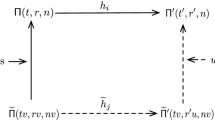Abstract
The ways the threshold parameter can be modified after the setup of a secret sharing scheme is the main theme of this work. The considerations are limited to the case when there are no secure channels. First we motivate the problem and discuss methods of threshold change when the dealer is still active and can use broadcasting to implement the change required. Next we study the case when participants themselves initiate the change of threshold without the dealer’s help. A general model for threshold changeable secret sharing is developed and two constructions are given. The first generic construction allows the design of a threshold changeable secret sharing scheme which can be implemented using the Shamir approach. The second construction is geometrical in nature and is optimal in terms of the size of shares. The work is concluded by showing that any threshold scheme can be given some degree of threshold change capability.
This work was partially supported by the Australian Research Council under grant number A49703076
This author was supported by the European Commission under ACTS project AC095 (ASPeCT)
Access this chapter
Tax calculation will be finalised at checkout
Purchases are for personal use only
Preview
Unable to display preview. Download preview PDF.
Similar content being viewed by others
References
G. R. Blakley. Safeguarding cryptographic keys. Proceedings of AFIPS 1979 National Computer Conference, 48:313–317, 1979.
B. Blakley, G.R. Blakley, A.H. Chan and J. Massey. Threshold schemes with disenrolment. Advances in Cryptology — CRYPTO’ 92, Lecture Notes in Comput. Sci., 740:540–548, 1993.
G. R. Blakley and C. Meadows. Security of ramp schemes. Advances in Cryptology — Proceedings of CRYPTO’ 84, Lecture Notes in Comput. Sci., 196:242–268, 1985.
C. Blundo, A. Cresti, A. De Santis and U. Vaccaro. Fully dynamic secret sharing schemes. Advances in Cryptology — CRYPTO’ 93, Lecture Notes in Comput. Sci., 773:110–125, 1993.
R. Capocelli, A. Santis, L. Gargano, and U. Vaccaro. On the size of shares for secret sharing schemes. Advances in Cryptology-CRYPTO’ 91, Lecture Notes in Comput. Sci., 576:101–113, 1992. also, Journal of Cryptology, vol. 6, no. 3, pp. 157–167, 1993.
Y. Desmedt. Threshold cryptography. European Transactions on Telecommunications, 5(41):449–457, 1994.
Y. Desmedt and S. Jajodia. Redistributing secret shares to new access structures and its applications. Preprint.
W.-A. Jackson and K.M. Martin. Geometric secret sharing schemes and their duals. Des. Codes Cryptogr., 4:83–95, 1994.
W.-A. Jackson and K.M. Martin. A combinatorial interpretation of ramp schemes. Australasian Journal of Combinatorics, 14:51–60, 1996.
A. Herzberg, S. Jarecki, H. Krawczyk, and M. Yung. Proactive secret sharing or: how to cope with perpetual leakage. Advances in Cryptology-CRYPTO’ 95, Lecture Notes in Comput. Sci., 963:339–352, 1995.
J.W.P. Hirschfeld. Projective geometries over finite fields. Clarendon Press, Oxford, 1979.
E. Karnin, J. Greene, and M. Hellman. On secret sharing systems. IEEE Transactions on Information Theory, vol. IT-29: 35–41, 1983.
K.M. Martin. Untrustworthy participants in secret sharing schemes. Cryptography and Coding III, Oxford University Press, 255–264, 1993.
K.M. Martin, R. Safavi-Naini and H. Wang. Bounds and techniques for efficient redistribution of secret shares to new access structures. Preprint.
A. Shamir. How to share a secret. Communications of the ACM, 22:612–613, 1979.
G. Simmons. How to (really) share a secret. Advances in Cryptology — CRYPTO’ 88, Lecture Notes in Comput. Sci., 403:390–448, 1990.
D.R. Stinson. An explication of secret sharing schemes. Des. Codes Cryptogr., 2:357–390, 1992.
Author information
Authors and Affiliations
Editor information
Editors and Affiliations
Rights and permissions
Copyright information
© 1999 Springer-Verlag Berlin Heidelberg
About this paper
Cite this paper
Martin, K.M., Pieprzyk, J., Safavi-Naini, R., Wang, H. (1999). Changing Thresholds in the Absence of Secure Channels. In: Pieprzyk, J., Safavi-Naini, R., Seberry, J. (eds) Information Security and Privacy. ACISP 1999. Lecture Notes in Computer Science, vol 1587. Springer, Berlin, Heidelberg. https://doi.org/10.1007/3-540-48970-3_15
Download citation
DOI: https://doi.org/10.1007/3-540-48970-3_15
Published:
Publisher Name: Springer, Berlin, Heidelberg
Print ISBN: 978-3-540-65756-9
Online ISBN: 978-3-540-48970-2
eBook Packages: Springer Book Archive




